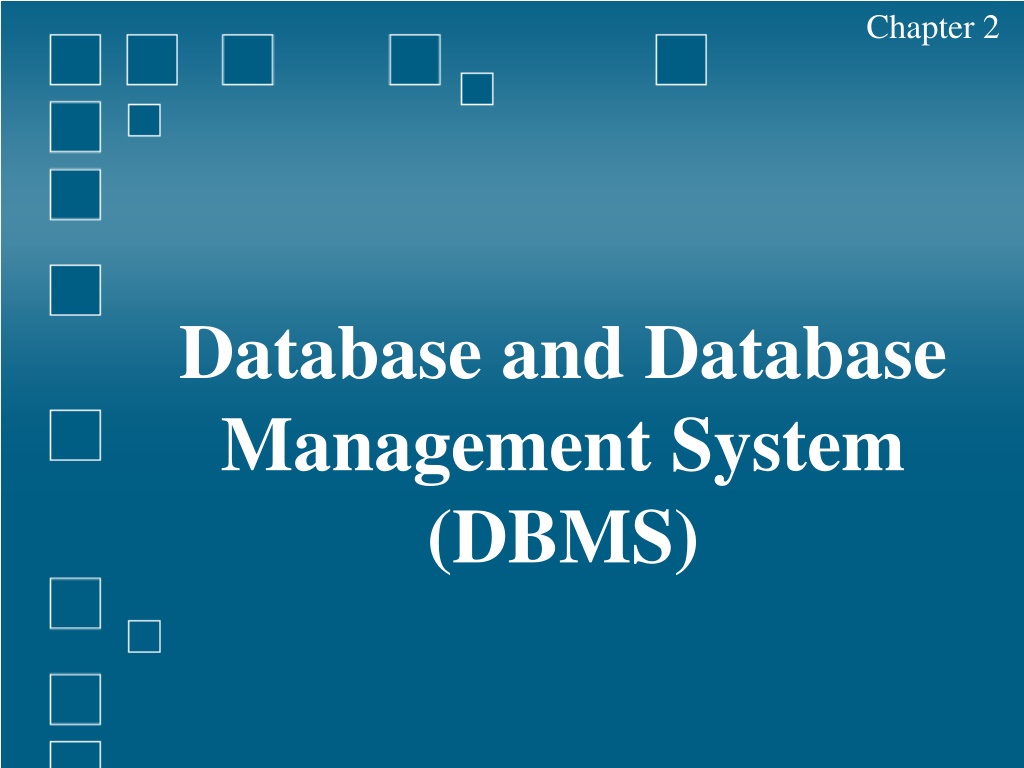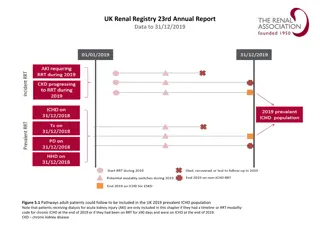
Understanding the Basics of Databases and DBMS
Explore the fundamentals of databases and Database Management Systems (DBMS) in this informative chapter. Learn about the advantages of DBMS, architecture, components, and the importance of data management. Discover different types of databases, such as relational and distributed, along with the role of SQL in database querying. See how databases are utilized in various sectors like banking, airlines, universities, and telecommunications.
Download Presentation

Please find below an Image/Link to download the presentation.
The content on the website is provided AS IS for your information and personal use only. It may not be sold, licensed, or shared on other websites without obtaining consent from the author. If you encounter any issues during the download, it is possible that the publisher has removed the file from their server.
You are allowed to download the files provided on this website for personal or commercial use, subject to the condition that they are used lawfully. All files are the property of their respective owners.
The content on the website is provided AS IS for your information and personal use only. It may not be sold, licensed, or shared on other websites without obtaining consent from the author.
E N D
Presentation Transcript
Chapter 2 Database and Database Management System (DBMS)
Chapter 2 Introduction Database management system (DBMS) Advantages of DBMS Architecture of DBMS Importance of DBMS Components of DBS environment Data independence Instance , schema and mapping ACID test
Chapter 2 1. Introduction A databaseis a collection of information that is organized so that it can easily be accessed, managed, databases can be classified according to types of content: bibliographic, full-text, numeric, and images. and updated.
In computing, databases are classified according to their organizational approach: relational database a tabular database A distributed database: is one that can be dispersed or replicated among different points in a network. An object-oriented programming database is one that is congruent with the data defined in object classes and subclasses.
Chapter 2 Computer databases typically contain aggregations of data records or files, such as sales transactions, product catalogs and inventories, and customer profiles. a database manager provides users the capabilities of controlling read/write access, specifying report generation, and analyzing usage. Databases and database managers are prevalent in large mainframe systems, but are also present in smaller distributed workstation and mid-range systems such as the AS/400 and on personal computers.
Chapter 2 SQL(Structured Query Language) is a standard language for making interactive queries from and updating a database such as IBM's Microsoft's SQL Server, and database products from Oracle, Sybase, and Computer Associates. DB2,
Chapter 2 1.1 Database System Applications Databases are widely used. Here are some representative applications: Banking: For customer information, accounts, and loans, and banking transactions. Airlines: For reservations and schedule information. Airlines were among the first to use databases in a geographically distributed manner terminals situated around the world accessed the central database system through phone lines and other data networks. Universities: For student information, course registrations, and grades. Credit card transactions: For purchases on credit cards and generation of monthly statements.
Chapter 2 Telecommunication: For keeping records of calls made, generating monthly bills, maintaining balances on prepaid calling cards, and storing information about the communication networks. Finance: For storing information about holdings, sales, and purchases of financial instruments such as stocks and bonds. Sales: For customer, product, and purchase information. Manufacturing: For management of supply chain and for tracking production of items in factories, inventories of items in warehouses/stores, and orders for items. Human resources: For information about employees, salaries, payroll taxes and benefits, and for generation of paychecks.
Chapter 2 2.1.2 Database Administrator One of the main reasons for using DBMSs is to have central control of both the data and the programs that access those data. DataBase Administrator (DBA): A person who has such central control over the system.
Chapter 2 The functions of a DBA include: 1. Schema definition. The DBA creates the original database schema by executing a set of data definition statements in the DDL. 2. Storage structure and access-method definition. 3. Schema and modification. The DBA carries out changes to the schema and physical organization to reflect the changing needs of the organization, or to alter the physical organization to improve performance. physical-organization
Chapter 2 4. Granting of authorization for data access. By granting different types of authorization, the database administrator can regulate which parts of the database various users can access. The authorization information is kept in a special system structure that the database system consults whenever someone attempts to access the data in the system.
Chapter 2 5. Routine maintenance. Examples of the database administrator s routine maintenance activities are: Periodically backing up the database, either onto tapes or onto remote servers, to prevent loss of data in case of disasters such as flooding. Ensuring that enough free disk space is available for normal operations, and upgrading disk space as required. Monitoring jobs running on the database and ensuring that performance is not degraded by very expensive tasks submitted by some users.
Chapter 2 2 . Database management system (DBMS) is a collection of interrelated data and a set of programs to access those data. The collection of data, usually referred to as the database, contains information relevant to an enterprise. The primary goal of a DBMS is to provide a way to store and retrieve database information that is both convenient and efficient.
Chapter 2 Database systems are designed to manage large bodies of information. Management of data involves both defining structures for storage of information and providing mechanisms manipulation of information. In addition, the database system must ensure the safety of the information stored, despite system crashes or attempts at unauthorized access. If data are to be shared among several users, the system must avoid possible anomalous results. for the
Chapter 2 2.2.1 Advantages of DBMS 1. Database organizations to place control of database development in the hands of database administrators (DBAs) and other specialists. 2. Data independence: Application programs should be as independent as possible from details of data representation and storage. The DBMS can provide an abstract view of the data to insulate application code from such details. Development: It allows
Chapter 2 3. Efficient data access: A DBMS utilizes a variety of sophisticated techniques to store and retrieve data efficiently. It allows different user application programs to easily access the same database. Instead of having to write computer programs to extract information, user can ask simple questions in a query language
Chapter 2 4. Data integrity and security: If data is always accessed through the DBMS, the DBMS can enforce : Integrity constraints on the data. For example, before inserting salary information for an employee, the DBMS can check that the department budget is not exceeded. Also, the DBMS can enforce access controls that govern what data is visible to different classes of users.
Chapter 2 4. Crash recovery: the DBMS protects users from the effects of system failures. 5. Data administration and Concurrent access: When several users share the data( more than one user access the database at the same time), DBMS schedules concurrent accesses to the data in such a manner that users can think of the data as being accessed by only one user at a time.
Chapter 2 2.2.2 The Three-Schema Architecture The goal of the three-schema architecture, is to separate the user applications from the physical database. In this architecture, schemas can be defined at the following three levels: 1. The internal level has an internal schema, which describes the physical storage structure of the database. The internal schema uses a physical data model and describes the complete details of data storage and access paths for the database.
Chapter 2 2. The conceptual level has a conceptual schema, which describes the structure of the whole database for a community of users. The conceptual schema hides the details of physical storage structures and describing entities, data types, relationships, user operations, and constraints. Usually, a representational data model is used to describe the conceptual schema when a database system is implemented. This implementation conceptual schema is often based on a conceptual schema design in a high-level data model. concentrates on
Chapter 2 3.The external or view level includes a number of external schemas or user views. Each external schema describes the part of the database that a particular user group is interested in and hides the rest of the database from that user group. The processes of transforming requests and results between levels are called mappings.
Chapter 2 Figure 2.1 The three level of architecture















